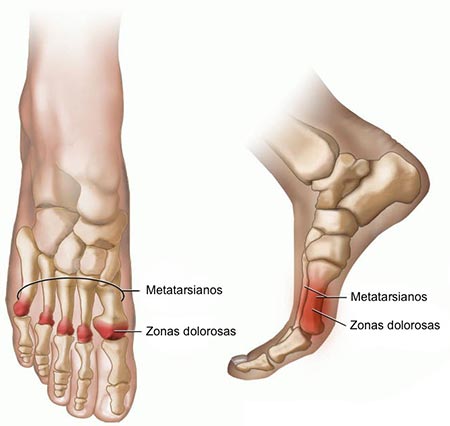Ball of Foot Pain (Metatarsalgia)
 Common causes of forefoot pain are high arched feet, loss of fat pad under the forefoot, calluses, Neuroma, and plantar plate syndrome
Common causes of forefoot pain are high arched feet, loss of fat pad under the forefoot, calluses, Neuroma, and plantar plate syndrome
Metatarsalgia, otherwise known as “ball of foot pain” is a generalized term for forefoot pain. Many different things can cause metatarsalgia, each of which may result in drastically different approaches to treatment. Common causes of forefoot pain are high arched feet, loss of fat pad under the forefoot, calluses, Neuroma, and plantar plate syndrome and your local foot doctor will help you get to an accurate diagnosis. All symptoms should always be evaluated with a thorough consultation and examination by your podiatrist for an accurate diagnosis and treatment plan to exclude any underlying serious condition.

People who experience chronic ball of foot pain often develop painful calluses on the skin under the foot.
The good news is, metatarsalgia is very treatable once a proper diagnosis is made by a foot doctor in New York. With Our Podiatrist’s help, you can get back on your feet and pain free in no time at all!
Symptoms
People who experience chronic ball of foot pain often develop painful calluses on the skin under the foot. When you age, you sometimes lose the padding of fat underneath the ball area of your foot, causing additional pressure to the area. Those who wear heels are more likely to suffer this sort of forefoot pain.
Consult a top podiatrist Our Podiatrists or your local podiatry doctor if you have chronic ball of foot pain. The following conditions may worsen metatarsalgia pain:
- Arthritis: Along with other joint conditions and diseases, arthritis can affect the metatarsal joints in the ball of your foot.
- Diabetes: A nerve-related condition called diabetic neuropathy can create foot pain.
- Skin lesions: Lesions and severe calluses can press on the metatarsals, creating ball of foot pain.
- Neuromas: Enlarged nerves often located between the metatarsals
- Injury: Stress fractures and other injuries to your metatarsal bones add to ball of foot pain.

Wearing custom insoles can relieve your ball of foot pain by reducing the pressure on your forefoot
Causes of Ball of Foot Pain (Metatarsalgia)
If you’re uncertain of the cause of your ball of foot pain, a podiatry doctor can help with this diagnosis. Let your Manhattan podiatrist know if you recently changed your shoes, took up a new sport or increased your activity level. It may help if you learn about the metatarsal region of your foot.
You have 5 metatarsal bones and each articulates with one of your five toes. The phalanges are the bones that make up your toes. These metatarsal bones distribute your weight, helping you to stand, walk, run and maintain proper balance.
Additional causes of ball of foot pain:
- Bone abnormalities: a bone abnormality often includes an unusually long metatarsal bone or when the metatarsals are angulated downward more than usual placing increased pressure on these bones
- Flat feet: This condition causes the foot to be in unlocked/unstable state, demanding more energy to move and control the foot during motion and standing.
- High arches: This is another condition that places pressure on your metatarsals.
- Hammer toes: A condition that affects the distribution of weight across your feet. Hammer toes are often lifted off the ground and the weight that they usually carry is placed on the metatarsals.
- Bunions: Bunions can develop if a person wears shoes that are too small, or they can be inherited. They are more common in women than men. This can lead to metatarsalgia. Most bunion surgeries include removing the bump from the big toe joint and shifting the bone over. A leading bunion surgeon in NYC, will perform a minimal incision over the deformity to obtain an optimal cosmetic end result
”
★ ★ ★ ★ ★Thank you so, so much for such a calming experience. I felt so comfortable and validated. I was anxious coming in, with a piece of glass in my foot, I left glass-free and with calmer.
Diagnosis for Ball of Feet Pain
Identifying the location of your foot pain may be difficult since sometimes the pain moves around. Before you visit a podiatrist in Manhattan, ask yourself the following questions to better prepare for your visit. If you are experiencing pain, make sure to tell your foot doctor at New York Podiatry as much as you can.
- Is your pain focused in one area or does it spread out across your foot?
- If the pain isn’t localized, does it radiate throughout the width or length of your entire foot?
- Do you feel the pain down to your toes or up your leg?
- What’s the nature of your pain? Is it dull and aching? Burning? Or sharp and shooting?
- Are any of your metatarsal bones inflamed? Does your foot feel swollen?
- Is it more painful when you walk around barefoot?
- Can you feel pain when you transfer weight to your affected foot?
- Is it more painful to stand on your toes?
- Can you feel it when you run or jump?
- Does it feel like you’re walking on a sharp stone or pebble?
It is important to explain your symptoms to your NYC foot doctor so a proper diagnosis can be made. If you answered yes to any of the above questions please report them to your doctor. Contact your local Manhattan podiatrist for a complete diagnosis.
All symptoms should always be evaluated with a thorough consultation and examination by your podiatrist for an accurate diagnosis and treatment plan to exclude any underlying serious condition.
Treatment Options
A good podiatry doctor in NYC can offer several non-invasive treatments will help most individuals suffering metatarsalgia.
There are some simple home remedies you can try to ease your ball of foot pain. The goal is to stretch your Achilles tendon or strengthen your foot muscles to decrease the ball of foot pain by reducing the pressure on your feet and specifically forefeet areas. Several treatment options we may offer you are:
- Physical therapy: Ultrasound and Electrical stimulation helps reduce inflammation.
- Orthotics: We can modify these to defer the pressure from your forefoot
- Padding: we can place pads in your shoe to alleviate pain
- Dermal Filler: Restylane is injected into ball of foot to pad pressure points
In the event that these non-surgical treatments fail to resolve your ball and foot pain, or if it continues to worsen, consult your Manhattan podiatric doctor or foot specialist about the possibility of metatarsalgia surgery. Surgery might be necessary to address ball of foot pain or correct bony abnormalities creating the discomfort. Metatarsalgia has many causes and your podiatric doctor will discuss your options during your office visit.
All symptoms should always be evaluated with a thorough consultation and examination by your podiatrist for an accurate diagnosis and treatment plan to exclude any underlying serious condition.
Do you have any questions about Ball of Foot Pain (Metatarsalgia) prevention or treatment? Would like to schedule an appointment with an internationally recognized, top NYC Podiatrist and foot doctor at Manhattan Foot Specialists? Please contact our office for a consultation.
In The Press

Call now to make an appointment with our award winning, board certified NYC podiatrists regarding your health. We look forward to seeing you!
book online now (212) 389-9918(212) 389-1886 Podiatrist (Midtown) 51 East 25th Street, Ste 451, NY 10010
(212) 389-1887 Podiatrist (Union Square) 55 W 17th St Ste 106, NY 10011
(212) 378-9991
